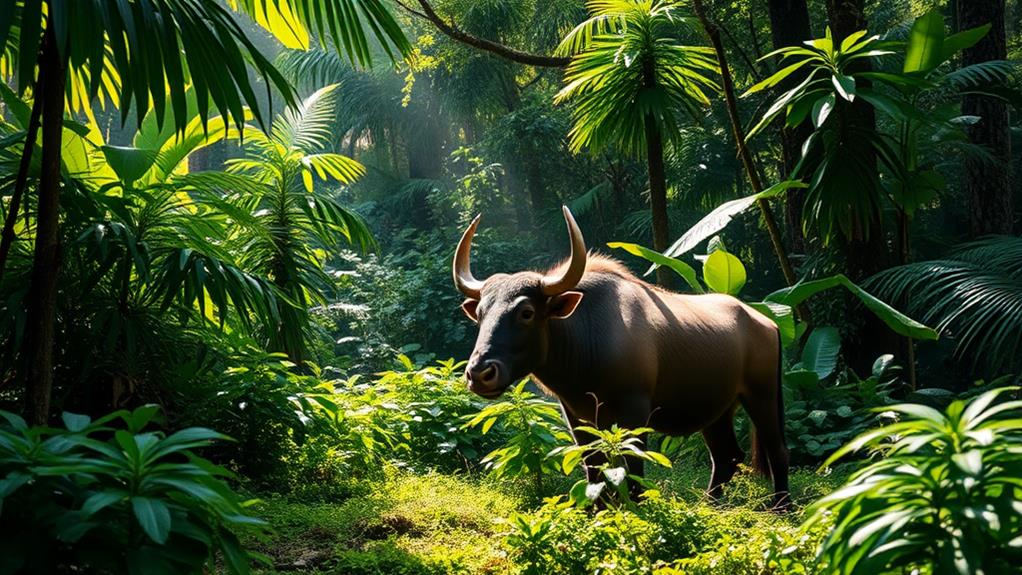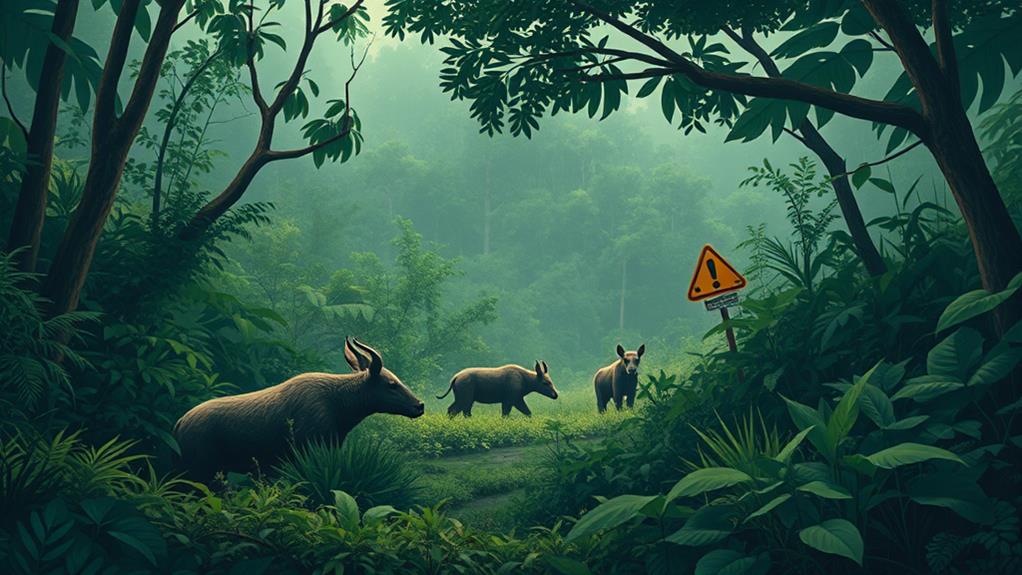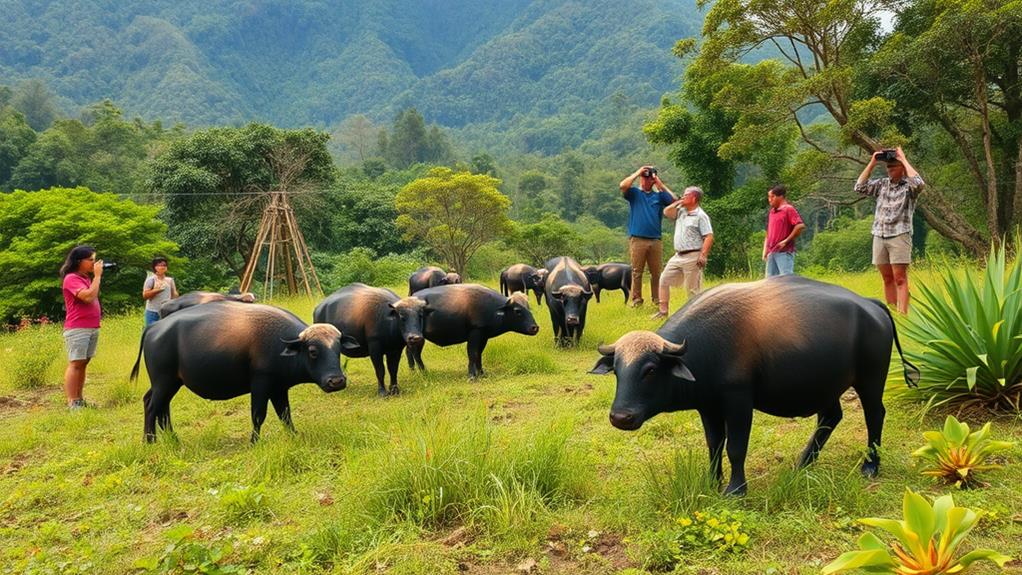Tamaraws, Critically Endangered Dwarf Buffaloes, Need Conservation Efforts
Tamaraws, the dwarf buffaloes of Mindoro Island, are critically endangered due to habitat loss and poaching. To address this, conservation initiatives are underway, including the National Tamaraw Conservation Action Plan, which aims to establish a thriving population by 2050.
Habitat Assessments and Community Engagement Are Key
Habitat assessments are crucial in identifying areas that need preservation and restoration.
Additionally, community engagement with Indigenous Mangyan tribes is vital, as they have traditional knowledge of the land and can assist in conservation efforts.
Ecotourism Supports Conservation and Community Prosperity
Ecotourism is on the rise, linking conservation to community prosperity.
By promoting responsible tourism, local communities can benefit economically while raising awareness about the Tamaraw's plight.
Conservation Efforts Hold Hope for the Future
While the journey to conserve Tamaraws is complex, there is hope.
Ongoing initiatives and future directions are crucial in protecting this unique species.
Overview of Tamaraws

Tamaraws: A Critically Endangered Species
Tamaraws, found only on Mindoro Island in the Philippines, are a unique and critically endangered species, with a dwindling population of approximately 400 individuals. This endemic dwarf buffalo, scientifically known as Bubalus mindorensis, requires urgent conservation efforts to prevent its extinction.
Physical Characteristics and Habitat
Standing about one meter tall and weighing up to 300 kg, Tamaraws are recognized by their dark brown to grayish coat and backward-pointing horns.
Historically, they roamed across Mindoro Island, but their habitat has been reduced to a mere 16,000 hectares within Mounts Iglit-Baco National Park.
Ecological Role and Threats
Tamaraws play a vital role in their ecosystem, primarily consuming leaves, shrubs, and grasses, thus maintaining ecological balance.
However, their population has drastically declined from over 10,000 in the early 1900s due to hunting, habitat loss, and disease.
Conservation Significance
The plight of the Tamaraw highlights the importance of habitat preservation and targeted conservation initiatives.
It's essential to raise awareness and support for the conservation of this unique species to ensure their survival.
Habitat and Distribution
The Tamaraw's habitat is limited to Mindoro Island, specifically the mountainous regions of Mounts Iglit-Baco National Park. This restricted range is a result of habitat destruction, which has significantly reduced the buffalo's living space. In the past, Tamaraws roamed a larger area, but now they're primarily confined to a core conservation zone of less than 16,000 hectares.
The Tamaraw population has increased to nearly 400 individuals, up from 200 in 2004. This growth is attributed to effective conservation efforts. However, the remaining populations are divided into three subpopulations: Mt. Calavite, Aruyan-Malati, and Mts. Iglit-Baco.
The Mts. Iglit-Baco subpopulation holds about 80% of the total Tamaraw population, making it a critical area for conservation.
Habitat destruction from slash-and-burn agriculture and competition with cattle ranching continues to threaten the Tamaraw's natural grazing areas. These human activities disrupt the delicate balance of the ecosystem, emphasizing the need for sustainable practices and conservation efforts to protect this iconic species.
Conservation Challenges

Conservation Challenges
The Tamaraw population has drastically declined from over 10,000 in 1900 to around 400 individuals today, primarily due to habitat destruction and illegal hunting. These threats are exacerbated by poaching, often facilitated by snares and traditional methods used by Indigenous communities.
Habitat destruction is a significant challenge, resulting in the loss of grazing land and corridors. This is largely caused by slash-and-burn agriculture and competition with cattle ranching, which have significantly reduced the Tamaraw's natural habitat.
For instance, the encroachment of human populations destroys their environment and limits their movement, threatening genetic diversity.
Illegal hunting has led to decreased population numbers. This is further complicated by limited law enforcement, which renders protection measures ineffective.
Balancing Indigenous rights with conservation goals is another challenge. Conservation efforts must respect the rights of Indigenous communities while protecting the Tamaraw.
To achieve this, collaboration between conservation programs and Indigenous communities is essential.
Addressing these multifaceted challenges is crucial for effective conservation. By working together, we can overcome the hurdles and secure a future for the Tamaraw.
Research and Findings
Tamaraw Conservation Progress and Challenges
Recent research and findings on Tamaraw conservation show both progress and ongoing challenges. Between 2012 and 2014, exploration missions assessed nearly 60,000 hectares, revealing alarming evidence of Tamaraw disappearance from previously inhabited areas.
However, the core population has nearly doubled since 2004, reaching almost 400 individuals, primarily within the designated conservation zone of Mounts Iglit-Baco National Park.
Habitat loss and poaching remain significant threats to these endemic dwarf buffaloes. To address these threats, research emphasizes the need for innovative management solutions that respect the rights and needs of indigenous Mangyan communities.
Effective conservation requires ongoing monitoring of Tamaraw ecology and distribution, enabling adaptive strategies that respond to evolving challenges.
Collaboration between organizations, such as No Conservation and the DABOVILLE Foundation, is crucial for integrating local community needs into conservation efforts.
By prioritizing the ecological well-being of both the Tamaraws and their habitats, we can work towards a sustainable future for these remarkable creatures.
Vigilance, adaptability, and community involvement are critical in ongoing Tamaraw conservation efforts.
Current Conservation Efforts

Effective Conservation of the Tamaraw Population
To safeguard the Tamaraw population while respecting local communities, the Tamaraw Program has been conducting extensive habitat assessments since 2012, covering nearly 60,000 hectares.
The goal is to strike a balance between conservation and community involvement. The recently launched National Tamaraw Conservation Action Plan aims to achieve a thriving Tamaraw population by 2050, emphasizing collaboration among government bodies, conservation organizations, and local stakeholders.
Current Initiatives and Their Impact
Rigorous conservation efforts have led to significant results.
Approximately 80% of the remaining Tamaraw population now resides in Mounts Iglit-Baco Natural Park, thanks to zero poaching initiatives and disease prevention measures. Invasive species management is also crucial in creating a conducive environment for the Tamaraw to flourish.
Community Involvement and Ecotourism
To enhance community involvement, ecotourism initiatives are being developed, generating income and fostering awareness about Tamaraw conservation.
By integrating local communities into these conservation strategies, we create a sustainable future for both the Tamaraw and the people who share its habitat.
With continued commitment, we can ensure that the Tamaraw survives for generations to come.
Community Involvement
Community Involvement is Key to Tamaraw Conservation
Community involvement is crucial for successful Tamaraw conservation efforts. This involves bridging the gap between ecological sustainability and local livelihoods.
Engaging indigenous Mangyan tribes ensures traditional knowledge and sustainable practices are integrated into conservation initiatives. For instance, establishing Indigenous Community Conserved Areas (ICCAs) allows local stakeholders to participate in decision-making processes that honor Mangyan rights and address their subsistence needs.
Ecotourism Supports Local Communities and Habitat Protection
Ecotourism plays a significant role in Tamaraw conservation by generating income for local communities while promoting habitat protection.
Local communities benefit from ecotourism initiatives, which contributes to habitat preservation. This communal effort fosters not only environmental stewardship but also strengthens cultural ties.
Partnerships Between Conservation Organizations and Indigenous Communities are Essential
Partnerships between conservation organizations and indigenous communities are vital for effective management of Tamaraw habitats.
Aligning conservation goals with local interests enhances both ecological and economic outcomes. These collaborations ensure that community engagement becomes a powerful movement that embodies mutual respect for nature and the rights of its stewards, ensuring a brighter future for the Tamaraw and its guardians.
Future Directions

Combating Poaching and Empowering Local Communities
To ensure the survival of the Tamaraw, enhancing law enforcement to combat poaching is crucial. Illegal hunting poses a significant threat to their survival, and protecting these endemic dwarf buffaloes from poaching is essential.
Integrating the needs and rights of the Indigenous Mangyan tribes is vital in developing effective conservation strategies that promote sustainable practices.
Advancing Research and Conservation
Ongoing research into Tamaraw ecology is necessary for monitoring population health and adapting conservation strategies as needed.
Expanding their range beyond the current core zone will safeguard their habitats more effectively.
Establishing Indigenous Community Conserved Areas (ICCAs) empowers local communities, ensures cultural preservation, and creates sanctuaries for Tamaraws.
Promoting Ecotourism and Community Engagement
Future initiatives will focus on ecotourism development, generating income for local communities and raising awareness about Tamaraw conservation.
This approach supports the livelihoods of the Mangyan tribes and fosters a deeper connection between people and their environment.
By prioritizing habitat safeguarding and community involvement, we can secure a brighter future for Tamaraws while enriching the cultural landscape of the region.
Importance of Ecotourism
Ecotourism plays a crucial role in linking conservation efforts with community prosperity, particularly in the preservation of the Tamaraw species. By participating in ecotourism initiatives, individuals can directly contribute to Tamaraw conservation while supporting local communities. This is because ecotourism generates income that encourages residents to adopt sustainable practices, essential for protecting the Tamaraw's habitat.
Collaborative ecotourism programs offer unique experiences, such as trekking tours and wildlife observation opportunities, allowing individuals to appreciate the Tamaraw in its natural habitat. This not only raises awareness about the species but also fosters public support for its conservation.
The Tamaraw's critical status highlights the importance of ecotourism as a strategic tool for resource management and community engagement.
The development of a Parks Management Plan demonstrates ecotourism's role in ensuring the Tamaraw's survival and the economic well-being of local residents. By supporting ecotourism initiatives, individuals can make a positive impact on the conservation of the Tamaraw and the communities that depend on it.
Questions and Answers
What Is the Conservation Action for Tamaraw?
Effective conservation actions for the Tamaraw involve habitat restoration and wildlife corridors to ensure species connectivity. This is crucial because the Tamaraw's habitat is limited to the Mount Kitanglad Range in Bukidnon, Philippines, and connecting habitats allows the species to roam freely and find food.
Community involvement is vital in Tamaraw conservation. Engaging locals through education programs fosters awareness and support, which is essential in preventing habitat destruction and poaching. For instance, the Philippine government has established the Tamaraw Conservation Program, which involves local communities in conservation efforts.
Anti-poaching measures and monitoring efforts are necessary to protect vulnerable Tamaraw populations. The Philippine government has implemented laws and regulations to prevent poaching, and conservation organizations conduct regular monitoring to track Tamaraw populations and detect any signs of poaching.
Sustainable tourism can generate funding initiatives for Tamaraw conservation. Eco-tourism activities, such as guided treks and wildlife watching, can provide income for local communities and support conservation efforts. For example, the Kitanglad Integrated NGOs (KIN) offers eco-tourism activities that support conservation efforts in the Mount Kitanglad Range.
Partnerships and collaborations are essential in Tamaraw conservation. The Philippine government, conservation organizations, and local communities must work together to develop and implement effective conservation strategies. For instance, the Tamaraw Conservation Program is a collaborative effort between the Philippine government, conservation organizations, and local communities.
Genetic research plays a vital role in understanding and maintaining Tamaraw biodiversity. Scientists study the Tamaraw's genetic makeup to understand its evolutionary history and identify ways to maintain genetic diversity.
This research informs conservation efforts and ensures that they're both informed and impactful for future generations.
How to Save Tamaraw From Extinction?
Protecting the Tamaraw's Habitat is Key
To prevent the Tamaraw from extinction, restoring its natural habitat is crucial. This involves reforestation efforts and creating wildlife corridors to connect isolated populations. For example, in the Philippines, conservationists are working to restore the Tamaraw's habitat in the Mount Kitanglad Range Natural Park.
Community Involvement is Vital
Engaging local communities is essential in the conservation of the Tamaraw. This can be achieved through awareness campaigns and ecological education, enabling locals to understand the importance of preserving the species. For instance, the Philippine government has launched education programs to raise awareness about the Tamaraw's plight among local communities.
Breeding Programs and Anti-Poaching Measures
Supporting breeding programs can help increase the Tamaraw population. This involves capturing and breeding endangered species in controlled environments, then releasing them back into the wild.
Implementing anti-poaching measures is also crucial to safeguard the Tamaraw's future. This includes working with local law enforcement agencies to combat poaching and habitat destruction.
Sustainable Tourism and Research Funding
Promoting sustainable tourism can benefit both conservation efforts and local economies. This involves supporting eco-tourism initiatives that allow visitors to observe the Tamaraw in its natural habitat while generating income for local communities.
Securing research funding is also essential to better understand the Tamaraw's behavior and develop effective conservation strategies.
Government Policies and Support
Advocating for effective government policies is crucial in ensuring the Tamaraw's survival. This involves pushing for laws that protect the species and its habitat, as well as providing financial support for conservation efforts.
Why Is the Dwarf Buffalo Endangered?
The dwarf buffalo is endangered due to a combination of threats.
One major factor is habitat destruction, which has significantly reduced their range. This is largely caused by agricultural expansion, as humans clear land for farming and other uses.
Additionally, human conflict has led to the destruction of their habitats.
Another significant threat is poaching, which has further decreased their population.
Disease outbreaks and climate change also pose risks to their survival. These threats have led to a limitation of genetic diversity, making the dwarf buffalo more vulnerable to extinction.
Conservation funding and awareness campaigns are essential to protect the dwarf buffalo. Without these efforts, their future remains uncertain. The dwarf buffalo, also known as the tamaraw, is a critically endangered species found in the Philippines. Conservation funding is needed to support habitat preservation and anti-poaching measures. Awareness campaigns aimed at educating the public about the importance of protecting the tamaraw and other endangered species like the visayan warty pig can help garner support and resources for their conservation. Without these efforts, these unique and important animals may face extinction.
Urgent action is needed to address these threats and ensure the survival of this remarkable species.
Why Is Tamaraw Critically Endangered?
Habitat loss and agricultural expansion are the primary reasons for the Tamaraw's critically endangered status, as they limit the animal's range. For instance, the conversion of their natural habitat into farmland and settlements has reduced their living space, making it difficult for them to survive.
Poaching is another significant threat to the Tamaraw population. Poachers hunt these animals for their meat, hide, and horns, leading to a decline in their numbers. Moreover, the lack of effective law enforcement and insufficient protection measures have allowed poaching to continue unchecked.
The introduction of invasive species has disrupted the Tamaraw's ecosystem, further threatening their survival. These invasive species compete with the Tamaraw for food and resources, making it even harder for them to adapt and thrive.
A genetic bottleneck caused by population decline has restricted the Tamaraw's resilience. This means that the limited gene pool has reduced the species' ability to adapt to changing environmental conditions, making them more vulnerable to diseases and other threats.
Human conflict and climate change have exacerbated the Tamaraw's problems. Climate change has altered their habitat and disrupted their food supply, while human conflict has led to the destruction of their habitat and the fragmentation of their population.
Disease outbreaks are a significant threat to the Tamaraw's survival.
Raising conservation awareness is crucial to addressing these issues and ensuring the species' survival. Every effort counts in reversing the decline of the Tamaraw and securing their future.